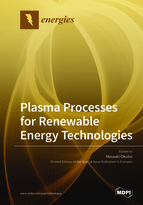Plasma Processes for Renewable Energy Technologies
A special issue of Energies (ISSN 1996-1073). This special issue belongs to the section "D1: Advanced Energy Materials".
Deadline for manuscript submissions: closed (30 June 2019) | Viewed by 28240
Special Issue Editor
Interests: nonthermal plasma; plasma denitrification; electrostatic precipitator; gas–liquid interfacial plasma; carbon dioxide reduction; biomass combustion; emission control for diesel engine; plasma surface treatment
Special Issue Information
Dear Colleagues,
The use of renewable energy is an effective solution for the prevention of global warming. On the other hand, environmental plasmas are one of powerful means to solve global environmental problems on nitrogen oxides, (NOx), sulfur oxides (SOx), particulate matter (PM), volatile organic compounds (VOC), and carbon dioxides (CO2) in the atmosphere. By combining both technologies, we can develop an extremely effective environmental improvement technology. Based on this background, a Special Issue of the journal Energies on plasma processes for renewable energy technologies is planned. On the issue, we focus on environment plasma technologies that can effectively utilize renewable electric energy sources, such as photovoltaic power generation, biofuel power generation, wind turbine power generation, etc. However, any latest research results on plasma environmental improvement processes are welcome for submission. We are looking, among others, for papers on the following technical subjects in which either plasma can use renewable energy sources or can be used for renewable energy technologies:
- Plasma decomposition technology of harmful gases, such as the plasma denitrification method;
- Plasma removal technology of harmful particles, such as electrostatic precipitation;
- Plasma decomposition technology of harmful substances in liquid, such as gas–liquid interfacial plasma;
- Plasma-enhanced flow induction and heat transfer enhancement technologies, such as ionic wind device and plasma actuator;
- Plasma-enhanced combustion and fuel reforming;
- Other environment plasma technologies.
Prof. Dr. Masaaki Okubo
Guest Editor
Manuscript Submission Information
Manuscripts should be submitted online at www.mdpi.com by registering and logging in to this website. Once you are registered, click here to go to the submission form. Manuscripts can be submitted until the deadline. All submissions that pass pre-check are peer-reviewed. Accepted papers will be published continuously in the journal (as soon as accepted) and will be listed together on the special issue website. Research articles, review articles as well as short communications are invited. For planned papers, a title and short abstract (about 100 words) can be sent to the Editorial Office for announcement on this website.
Submitted manuscripts should not have been published previously, nor be under consideration for publication elsewhere (except conference proceedings papers). All manuscripts are thoroughly refereed through a single-blind peer-review process. A guide for authors and other relevant information for submission of manuscripts is available on the Instructions for Authors page. Energies is an international peer-reviewed open access semimonthly journal published by MDPI.
Please visit the Instructions for Authors page before submitting a manuscript. The Article Processing Charge (APC) for publication in this open access journal is 2600 CHF (Swiss Francs). Submitted papers should be well formatted and use good English. Authors may use MDPI's English editing service prior to publication or during author revisions.
Keywords
- nonthermal plasma
- plasma denitrification
- electrostatic precipitator
- gas–liquid interfacial plasma
- ionic wind
- plasma actuator
- plasma enhanced combustion
- fuel reforming






